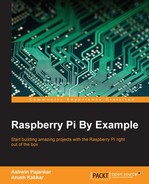This chapter was unique in the sense that we learned how to execute software not on a single Raspberry Pi but on multiple ones. We learned the advantages of using parallel computation and learned how to build our own network of clustered Raspberry Pi devices. We also learned how to install the libraries required for parallel computations so that we can run our own software in the cluster. We learned how to configure the Raspberry Pis in our network to communicate with each other and make the communication hassle-free. Once we set up a system, we tested it to to measure the response in the form of latency.
Finally, we learned about the concept of N-body simulation and configured an open source program to simulate it. W also saw how increasing the number of bodies in the simulation could affect the speed of the program's execution.
In the next chapter, we will expand upon this knowledge about clusters and learn about advanced networking concepts, such as DNS and DHCP. We will learn how to add functionalities such as a domain name service and auto detection of nodes and how to initiate a remote shutdown of the cluster.
